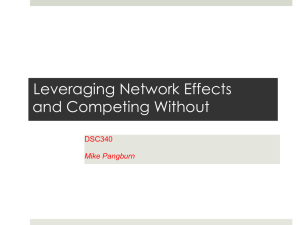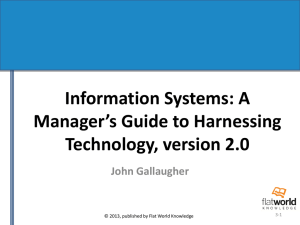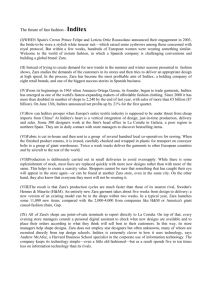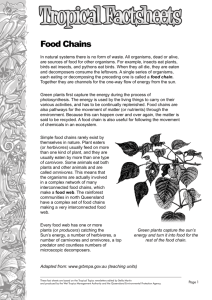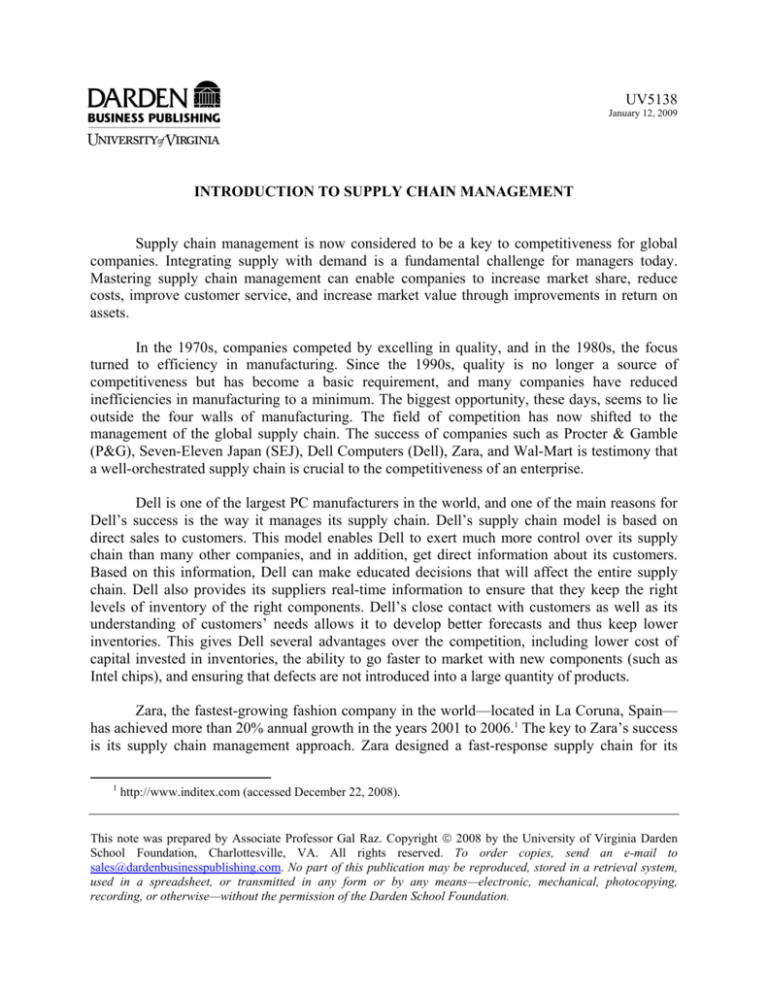
UV5138
January 12, 2009
INTRODUCTION TO SUPPLY CHAIN MANAGEMENT
Supply chain management is now considered to be a key to competitiveness for global
companies. Integrating supply with demand is a fundamental challenge for managers today.
Mastering supply chain management can enable companies to increase market share, reduce
costs, improve customer service, and increase market value through improvements in return on
assets.
In the 1970s, companies competed by excelling in quality, and in the 1980s, the focus
turned to efficiency in manufacturing. Since the 1990s, quality is no longer a source of
competitiveness but has become a basic requirement, and many companies have reduced
inefficiencies in manufacturing to a minimum. The biggest opportunity, these days, seems to lie
outside the four walls of manufacturing. The field of competition has now shifted to the
management of the global supply chain. The success of companies such as Procter & Gamble
(P&G), Seven-Eleven Japan (SEJ), Dell Computers (Dell), Zara, and Wal-Mart is testimony that
a well-orchestrated supply chain is crucial to the competitiveness of an enterprise.
Dell is one of the largest PC manufacturers in the world, and one of the main reasons for
Dell’s success is the way it manages its supply chain. Dell’s supply chain model is based on
direct sales to customers. This model enables Dell to exert much more control over its supply
chain than many other companies, and in addition, get direct information about its customers.
Based on this information, Dell can make educated decisions that will affect the entire supply
chain. Dell also provides its suppliers real-time information to ensure that they keep the right
levels of inventory of the right components. Dell’s close contact with customers as well as its
understanding of customers’ needs allows it to develop better forecasts and thus keep lower
inventories. This gives Dell several advantages over the competition, including lower cost of
capital invested in inventories, the ability to go faster to market with new components (such as
Intel chips), and ensuring that defects are not introduced into a large quantity of products.
Zara, the fastest-growing fashion company in the world—located in La Coruna, Spain—
has achieved more than 20% annual growth in the years 2001 to 2006.1 The key to Zara’s success
is its supply chain management approach. Zara designed a fast-response supply chain for its
1
http://www.inditex.com (accessed December 22, 2008).
This note was prepared by Associate Professor Gal Raz. Copyright 2008 by the University of Virginia Darden
School Foundation, Charlottesville, VA. All rights reserved. To order copies, send an e-mail to
sales@dardenbusinesspublishing.com. No part of this publication may be reproduced, stored in a retrieval system,
used in a spreadsheet, or transmitted in any form or by any means—electronic, mechanical, photocopying,
recording, or otherwise—without the permission of the Darden School Foundation.
-2products that incorporates all the different stages in its supply chain, from
manufacturing to distribution and retailing. Due to high demand uncertainty in
industry and the high cost of mistakes, Zara’s supply chain approach enables it
design and production decisions within a fashion season instead of well in advance
resulting in better response to demand.
UV5138
design and
the fashion
to make its
of a season,
SEJ posted record profits during the Asian economic crisis, and it did this by being one of
the most innovative companies in the world in the management of its supply chain. SEJ focused
on the demand side of the business and the smart use of information to achieve efficient use of
scarce shelf space. This was strategically important because of the high cost of real estate in
Japan. The company introduced systems to analyze hourly sales trends each day and make the
results available to all stores and suppliers by early the following day. This supported efficient
product replenishment: giving stores a high level of stock availability by determining the right
quantity of the right products.
By recognizing data as the key to success, and developing elaborate information systems
in tandem with agile logistics, SEJ achieved significantly higher sales per store than its
competitors. Its systems delivered dividends: low operational costs, low inventories, short cycle
times, and high customer service, which resulted in increased sales, better market penetration,
higher profits, and superior shareholder returns.
SEJ demonstrates the importance of sharing information, but in this case, informationsharing is not that difficult to achieve because the information remains within the boundaries of
one organization. More difficult problems arise when it is necessary to share information among
different organizations.
Some companies have taken information-sharing to sophisticated levels of informationcoordination and knowledge-exchange among supply chain partners. Such knowledge-sharing
can include capacity plans, production schedules, promotion plans, demand forecasts, and
shipment schedules. But seeking a deeper level of information- or knowledge-exchange demands
a greater degree of trust. So the business conditions and supply chain partners will need to
support that approach.
A good example of how this can work is the introduction of a program called
Collaborative Planning, Forecasting, and Replenishment (CPFR) by U.S. pharmaceutical and
health-care products manufacturer Warner-Lambert (now Pfizer) in the mid-1990s. The
program’s goal was to streamline product flow by sharing its strategic plans, performance data,
and market insights with key retailer Wal-Mart. The program also recognized that the
manufacturer could benefit from the retailer’s market knowledge, which was incorporated into
the CPFR model. As a result of this demand forecast collaboration, Warner-Lambert increased
-3-
UV5138
its products’ shelf-fill rate from 87% to 98%, earning the company about $8 million a year in
additional sales.2
These examples of large companies such as SEJ, Dell, Zara, and Wal-Mart illustrate two
of the key issues for supply chain success: first, coordination and collaboration, and second, the
value of information-sharing. Coordination and collaboration mean that the whole supply chain
operates as one entity. Instead of each party trying to operate in its own interest, the parties will
work together in the interests of the whole supply chain. The crucial requirements are the ability
to share information among supply chain partners, as well as aligning the parties’ incentives.
Next, we provide some definitions for supply chain management. We discuss the issue of supply
and demand uncertainty and how to align the supply chain strategy with the product demand and
supply characteristics.
Supply Chain Management Definitions
A supply chain consists of all the parties involved directly or indirectly in fulfilling a
customer request. (This definition doesn’t reveal whether a customer request is for a product or a
service. But when discussing services, sometimes the supply chain is referred to as a value
chain.) In this note, we will focus mainly on supply chains for products, although some of the
analysis would be equally appropriate for services.
Consider a customer walking into a Wal-Mart to purchase diapers. The supply chain
begins with the customer’s order of diapers. The next stage is the Wal-Mart store that the
customer visits. Wal-Mart will have an inventory of diapers supplied from a finished-goods
distribution center (warehouse) managed by Wal-Mart or by a third-party distributor. That
distributor receives its stock from the manufacturer, for example, P&G, which produces
Pampers. The P&G Pampers production line receives raw materials from a variety of suppliers,
including tape from 3M and plastic wrap from Film Fabricators Inc. Those suppliers’ raw
materials may be supplied by lower-tier suppliers. The Pampers’ supply chain is shown in
Figure 1.
2
H. L. Lee, “Creating Value Through Supply Chain Integration,” Supply Chain Management Review,
(September–October 2000), 40–6.
-4-
UV5138
Figure 1. Supply chain for Pampers diapers.
Chemical
Manufacturer
Plastic
Manufacturer
Film
Fabricators
Inc.
Other
Manufacturer
P&G or
Other
Manufacturer
Upstream
Wal-Mart or ThirdParty Distribution
Center
3M
Tape
Manufacturer
Timber
Company
Wal-Mart
Store
Customer
Downstream
Paper
Manufacturer
Supply chain management involves answering a number of questions about the supply chain:
Where are materials sourced? Where are they built?
What channels of distribution are used?
How are strong relationships built with suppliers and customers?
How is direct information from end consumers gathered and accessed?
What logistics structure is used?
How are information flows and systems coordinated globally?
How can incentive systems for all partners in the supply chain be set up so that the
overall performance of the chain can be optimized?
Supply chain management can be defined as the effective control of the flows of material,
information, and finance in a network consisting of suppliers, manufacturers, distributors, and
-5-
UV5138
customers. Table 1 describes the different flows in the supply chain. Material flows include both
physical product flows from the suppliers to the end customers (which we call downstream) and
the reverse flows (which we call upstream) such as returns, repairs, and servicing.
Table 1. Classification of supply chain flows.3
Information
Material
Finance
Upstream
Sales, orders, inventory,
quality, promotion plans
Returns, repairs, servicing,
recycling, disposal
Payments, consignments
Downstream
Capacity, promotion plans,
delivery schedules
Raw materials, intermediate
products, finished goods
Credits, consignment, payment
terms, invoice
In order to discuss the flows in Table 1, consider the supply chain for the General Motors
Service Parts Organization (GMSPO) illustrated in Figure 2. GMSPO manages more than 4
million SKUs (stock-keeping units). GM procurement managers purchase raw materials and
subassemblies. The parts production plants (PPP) produce some of these SKUs. The parts
distribution centers (PDCs) replenish their inventories by ordering both from GM suppliers and
PPPs. The 8,000 dealers located across North America also carry inventory ultimately to satisfy
consumer demand on time when needed. GMSPO was formed to coordinate and to create
visibility across this extended supply chain.
Figure 2. GM parts distribution network.
Dealers
Suppliers
Parts Plant
Replenishment orders
Distribution
Center
Customers
Service request
A key to delivering this service to GM customers is the information flow. This involves
information about parts’ orders and sales to be shared with the upstream parties as well as the
3
Lee, 2000.
-6-
UV5138
sharing of capacity and delivery schedules information with the downstream parties. As we
mentioned above, information flow is critical to supply chain success. For example, if Wal-Mart
runs a special promotion for Pampers, it is crucial that Wal-Mart informs P&G about it given
that the promotion will increase the sales of Pampers. This means that P&G should build more
inventory, but it also means that when making forecasts for the next period, P&G should not take
that increase in sales as an increasing trend in purchasing diapers, but rather be aware of the
connection between those sales and the promotion.
The financial flow includes all the different payments and credits in the supply chain,
including payment terms agreed upon by the different parties in the supply chain.
The objective of every supply chain is to maximize the overall value generated by the
chain. The value generated by a supply chain is the difference between what the final product is
worth to the customer and the total costs across the supply chain.
For example, if a customer purchases a GM car for $20,000 (which represents the
revenue the supply chain receives from the product), the value generated by the supply chain is
equal to the difference between $20,000 and the total costs the supply chain spent on production,
inventory, transportation, and so on. This value represents the supply chain profitability from this
car that will be shared by all the different parties within the supply chain.
We measure the success of the supply chain by looking at the total supply chain
profitability instead of the local profits of the individual supply chain stages. In order to be
successful, a supply chain should try to work as one entity to maximize supply chain
profitability. Thus it is clear that when a customer purchases Pampers in a Wal-Mart store, only
the customer purchase provides a positive financial flow—all the other financial flows described
in Table 1 are simply fund exchanges between the different parties in the supply chain. In order
to maximize the supply chain value, we need to manage the different flows described in Table 1
in the most efficient way.
Making the Supply Chain Fit Your Product
Managing supply chains effectively is a difficult and challenging task caused by the
current business trends of shortening product life cycles, increased product variety, globalization
of business, and the growing advances in information technology. A recent survey conducted by
Booz Allen and Hamilton4 showed that one of the key reasons for the failure of companies to
benefit from their supply chain is a lack of fit of the overall strategy with the supply chain
strategy. A common mistake that numerous companies make is to choose a supply chain strategy
that does not match the company’s product characteristics. Many companies believe that the role
of a supply chain strategy is to reduce costs and be efficient. This might be true when your
4
P. Heckmann, D. Shorten, and H. Engel, “Supply Chain Management at 21—The Hard Road to Adulthood,”
Booz Allen and Hamilton publications, 2003.
-7-
UV5138
product is a low-margin one with low demand uncertainty; however, it could be a devastating
mistake to use this kind of strategy for high-margin fashion products. Zara’s phenomenal growth
and success is due to its ability to choose a supply chain strategy that fits its product and its
overall business strategy. This means that when designing a supply chain strategy, managers
need to ensure it is aligned with the product it is supporting and more specifically with the
uncertainties related to this product. We can divide the product uncertainties into two main types:
demand uncertainties and supply uncertainties.
Demand-side uncertainty
When considering the demand uncertainty, products can be classified into two major
categories: primarily functional or primarily innovative based on their product life cycle, demand
predictability, product variety, and market standards for lead time.5
Functional products have long product life cycles and therefore more stable demand,
while innovative products have short life cycles with high innovation and fashion contents that
result in highly unpredictable demand. Examples of functional products include groceries, basic
clothing, food, and oil and gas, whereas examples of innovative products might be fashion
apparel, computers, and telecom products.
Table 2 summarizes the differences between functional and innovative products. As can
be seen, functional products have less product variety than innovative products due to the
fashion-based nature of those products and the advances in technology that result in frequent
introduction of new products. Due to long product life cycles and less product variety, demand
for functional products is much easier to forecast than that of innovative products. But the
simplicity of forecasting and the stability of the product lure many competitors to enter the
market for functional products, and thus their profit margins are smaller than those of innovative
products and their cost of obsolescence is lower.
Table 2. Characteristics of functional and innovative products.6
Product life cycle
Contribution margin
Product variety
Margin of error in demand forecast at time of production
commitment
Average stock-out rate
Forced end of the season markdowns as % of full price
Lead time required for made-to-order products
5
Functional
More than 2 years
5%–20%
Low (10–20 variants
per category)
10%
Innovative
2 months to 1 year
20%–60%
High (Hundreds of
variants per category)
40%–100%
1%–2%
0%
6 months to 1 year
10%–40%
10%–25%
1 day to 2 weeks
M. L. Fisher, “What is the Right Supply Chain for Your Product?” Harvard Business Review (March–April
1997), 105–16.
6
Fisher, “What is the Right Supply Chain for Your Product?”
-8-
UV5138
Supply-side uncertainty
It is not enough to consider demand uncertainties alone when devising a supply chain
strategy. We also need to consider the supply side. Supply processes can be categorized into two
main categories: stable supply processes and evolving supply processes.
A stable supply process is one where the manufacturing process and the underlying technology
are mature, and the supply base is well established. An evolving supply process is one where the
manufacturing process and the underlying technology are still under development and are
changing rapidly; as a result, the supply base may be limited in both size and experience. Table
3 describes the differences between stable and evolving supply processes.
Table 3. Characteristics of stable and evolving supply processes.7
Breakdowns
Process stability and yield
Quality
Supply sources
Reliability of suppliers
Process changes
Capacity constraints
Changeover
Flexibility
Lead time
Stable
Fewer breakdowns
Stable and higher yields
Fewer quality problems
More supply sources
Reliable suppliers
Fewer
Fewer capacity constraints
Easier to change over
Flexible
Dependable lead time
Evolving
Vulnerable to breakdowns
Variable and lower yields
Potential quality problems
Fewer supply sources
Unreliable suppliers
More
Potential capacity constraints
Difficult to change over
Inflexible
Variable lead time
As can be seen in Table 3, in a stable supply process, the manufacturing complexity
tends to be low or manageable and the manufacturing processes are usually highly automated
with long-term supply contracts. In an evolving supply process, conversely, the manufacturing
process will require much more attention and is subject to breakdowns and uncertain yields. In
addition, in this case, because the suppliers themselves might be going through process
innovations, the supply base will be less reliable than in the case of stable supply processes.
Although functional products tend to have more mature and stable supply processes, that
is not always the case. Table 4 provides examples of functional products that have high supply
uncertainties. One example would be some food products—especially fruits and vegetables.
Even if demand for those products is stable and predictable, the supply might be uncertain both
with respect to its quantity and with respect to its quality due to weather conditions.
7
H. L. Lee, “Aligning Supply Chain Strategies with Product Uncertainty,” California Management Review
(Spring 2002), 105–19.
-9-
UV5138
Supply Uncertainty
Table 4. Uncertainty framework examples.8
Demand Uncertainty
Low
High
(Functional products)
(Innovative products)
Low
(Stable process)
Grocery, basic apparel,
food, oil and gas
Fashion apparel, computers,
pop music
High
(Evolving process)
Hydroelectric power, some
food products
Telecom, high-end
computers, semiconductor
Supply Chain Strategies
From the uncertainty framework in Table 4, it is clear that products can be divided into
four groups based on their supply and demand uncertainties. Thus, when we try to devise the
supply chain strategy to match the product uncertainties, we have four types of strategies that
correspond to those four product types:
1. Efficient supply chains
2. Risk-hedging supply chains
3. Responsive supply chains
4. Agile supply chains
Table 5 provides the uncertainty framework that matches each of the product types with
the right supply chain strategy.
Supply Uncertainty
Table 5. The uncertainty framework with matched strategies.9
8
9
Demand Uncertainty
Low
High
(Functional products)
(Innovative products)
Low
(Stable process)
Efficient supply chains
Responsive supply chains
High
(Evolving process)
Risk-hedging supply
chains
Agile supply chains
Lee, 2002, 108.
Lee, 2002.
-10-
UV5138
Efficient supply chains
Efficient supply chains focus on producing the highest cost efficiencies in the supply
chain. When products have both low demand and low supply uncertainties, the basis for
competition is efficiency. In order to gain such efficiencies, the company should try to eliminate
non-value-added activities and focus on getting the best capacity utilization in production and
distribution. In addition, the firm should utilize the advances in information technology to link all
the activities to increase efficiency.
A company could achieve cost efficiency in two major ways: productivity improvements
and effective logistics and distribution. Using lean operations, automation, facility layout, or
workflow streamlining could help companies realize productivity improvements. Many Japanese
manufacturers focus on these types of improvements to cut cost and gain efficiency. For products
that have stable demand and supply processes, it might be possible to ship them directly from the
manufacturing facility to the stores utilizing an effective logistics system.
One of the biggest drug-store chains in the United States, Longs Drugs, uses state-of-theart scientific replenishment optimization software to plan replenishments to its warehouses and
stores, which has resulted in inventory savings of 40%. This enabled Longs Drugs to use the
savings to purchase 20 new stores.10
Risk-hedging supply chains
Risk-hedging supply chains focus on pooling and sharing resources in a supply chain in
order to share the risks of supply disruption. When supply processes are still evolving, they are
faced with uncertainties regarding yield, process reliability, supply source, and lead time. In this
case, companies need to find ways to prevent those uncertainties from affecting the demand
fulfillment. This can be achieved using strategies such as inventory pooling among different
facilities (stores or warehouses) so that the order fulfillment process will not be disrupted due to
component shortages. Companies that use risk-hedging strategies may also need to develop
multiple supply bases in order to have backup sources for their products. Although the cost of
having those multiple sources might be high, it will reduce the risk of supply shortages that can
be even more costly.
The Internet is a tool that companies can use in order to transfer supply and demand
information and increase the efficiency of risk pooling. One example of the use of the Internet is
e-marketplaces such as Covisint that was established by the big three car manufacturers in the
United States and later joined by Nissan and Renault. Through this public e-marketplace the
companies can locate many supply sources, which reduces the risk of supply shortages as well as
lead times for the components.
10
Hau L. Lee and Seungjin Whang, “Demand Chain Excellence: A Tale of Two Retailers,” Supply Chain
Management Review (January 2001).
-11-
UV5138
Responsive supply chains
Responsive supply chains aim to be responsive and flexible to changing and diverse
customer needs. These strategies are suitable for cases when demand is highly unpredictable with
a short selling season, which could result in excessive inventory, which in turn, might be very
costly for innovative products. Rather than focusing on accurate forecasting and inventory
planning, companies with stable supply processes and product technology should focus on
building a responsive and flexible supply chain using concepts such as postponement and buildto-order strategies.
One of the best examples for the use of responsive supply chain strategies is the fashion
industry. Due to the innovative nature of the product and the stability of the supply processes,
companies use responsive supply chain strategies to deal with the fashion gamble, which can
result in having too much stock at the end of the season and having to discount steeply to sell it.
Fashion companies such as Benetton, Sport Obermeyer, and Zara use the concept of
responsiveness in order to cope with this fashion gamble.
Benetton used the idea of postponement by redesigning its sweater manufacturing
process from dye first, knit second, to knit first, dye second, thereby postponing the color
decision until more information about the demand for different colors arrived.
Sport Obermeyer, a skiwear manufacturer based in Aspen, Colorado, developed a
concept of accurate response whereby the company first produces the products with more
predictable demand before the season and makes the unpredictable products within the season,
after more demand information becomes available.11
Similarly, Zara designed a fast-response supply chain for its fashion products
incorporating all the different stages in its supply chain, from design and manufacturing to
distribution and retailing. Zara’s fast-response supply chain involves designing and
manufacturing more than 10,000 designs per year, although in small batches. This enables Zara
to avoid the fashion gamble because designs that do not sell can be transferred to other stores and
Zara can decide not produce more of them. Like Sport Obermeyer, Zara purposely keeps its
manufacturing facilities at low utilization within the season to give the company the flexibility to
react to the more accurate demand information available in those times. In addition, in order to
be able to respond quickly and not hold too much inventory, Zara uses planes and trucks instead
of trains and ships. This high cost of transportation is balanced by the reduced cost of
maintaining more inventory and the avoided losses of discounting products at the end of the
fashion season. Zara’s fast-response system means that it takes only 15 to 30 days to deliver new
styles anywhere in the world (from design and production through to store delivery). The big
advantage for Zara was that it could make its design and production decisions within a fashion
season instead of well in advance of a season, resulting in a better response to demand. For the
11
M. L. Fisher, J. H. Hammond, W. R. Obermeyer, and A. Raman, “Making Supply Meet Demand in an
Uncertain World,” Harvard Business Review (May–June 1994), 83–93.
-12-
UV5138
retailers, Zara’s system allowed them to receive product soon after they ordered it and provided
something new to sell every two weeks without having to hold much inventory.12
Agile supply chains
Agile supply chains are responsive and flexible to customers’ needs, while hedging for
the risks of supply shortages and disruptions by pooling inventories or other capacity resources.
An example of a company that utilizes this type of strategy is Xilinx Inc., a “fabless”
semiconductor company. (Fabless—without fabrication—refers to outsourcing the
manufacturing of silicon wafers while keeping the function of design, development, and
marketing.) Xilinx specializes in highly innovative high-end integrated circuits that often
represent the first generation of the most powerful integrated circuits. Based on the nature of the
product, the technology processes used are very challenging and demanding, with a need for a
highly sophisticated fabrication facility. Thus, Xilinx created a close partnership with two
foundries, United Microelectronics Corporation in Taiwan and Seiko in Japan. Fabricated wafers
are stocked by the foundries, forming a decoupling point known as die banks. Then, as demand
for specific chips is revealed through orders from customers such as Dell, Motorola, and HP,
other supply partners in Taiwan and the Philippines carry out the final assembly and testing.
Using this decoupling point strategy, Xilinx is therefore able to be responsive to its customer
needs despite its evolving supply process.13
Another example is Cisco, which embarked on a very ambitious project to create an ehub that will link multiple tiers of suppliers via the Internet in order to coordinate supply and
demand planning across the supply chain. This e-hub also provides an opportunity to discover
potential supply and demand problems early so that supply chain partners can take appropriate
actions.
12
K. Ferdows, M. A. Lewis, and J. A. D. Machuca, “Rapid-Fire Fulfillment,” Harvard Business Review
(November 2004), 104–10.
13
Lee, 2002.



